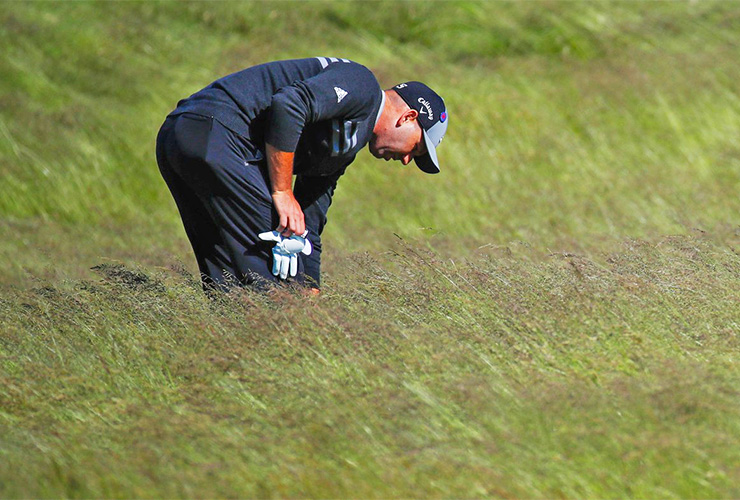By John Huggan
There’s one thing absolutely not in doubt—that there is a line that has been crossed. Multiple times, too, as those who have witnessed any, some or all of what the British tabloids long ago labelled “U.S. Open cock-ups” will surely testify.
Payne Stewart’s ball rolling inexorably down the steeply canting 18th green at The Olympic Club in 1998 comes to mind. So do Retief Goosen and Stewart Cink’s comedic putting on the 18th green—the only one not cut that day—at Southern Hills in 2001.
The unreachable fairway on the 10th hole at Bethpage Black in 2002 lives on in the memory. And Tiger Woods’ second-round 69 at Oakmont in 2007 was evidence enough of a course set-up that all but extinguished imagination and flair. At the top of his game, the man whose best golf is surely the best ever seen could shoot no better than 69? Something was clearly amiss with the course.
But the daddy of them all was Shinnecock Hills in 2004.
Starved of water, by the morning of the final round some holes and greens were all but unplayable. On the par-4 10th green with a birdie in his sights, Sweden’s Joakim Haeggman wound up putting back down the fairway. He ended up making a quintuple-bogey 9.
It was the 190-yard par-3 seventh hole, however, that turned out to be most notorious. Modelled on the famous Redan hole at North Berwick, the seventh is actually a nice hole. But with the green baked to a nonsensical crispness, anarchy ensued. Of the first four men off the tee that morning, three made triple bogeys. American Billy Mayfair hit a two-foot putt for par that finished in a bunker. A farce.
OK, while these examples represent incontrovertible evidence of a line being crossed, it begs a certain question: Where exactly is that line? It is a query some find easy to answer, others not so much.

The 14th hole at Shinnecock Hills. (Copyright USGA/John Mummert)
“For me ‘the line’ starts and finishes on the greens,” says 2010 U.S. Open champion Graeme McDowell. “I watched the coverage of 2004’s final round on television last night. The greens looked to be about a foot too quick. That was the root of the problem. And it was the same in 2016 when Dustin Johnson had his moving-ball issue at Oakmont. The greens were just too fast. And that is the most important line. It is architecture versus agronomy. When you have old-school architecture mixed with modern agronomy it can lead to trouble.”
Another former champion, 1988 and 1989 winner Curtis Strange, is also worried by the excessive green speeds attained during America’s national championship.
“Who said U.S. Open greens are supposed to be so fast?” he asks rhetorically. “Where does it say that to make a course tough and fair the greens have to encourage defensive putting? Let’s say we went back to greens running at 9½ on the Stimpmeter. Now you can put pins on some slopes. I grew up on greens like that. I remember hitting five-footers with huge breaks on them. That’s how you find out who can putt—and read greens.
Strange, the classic U.S. Open grinder, makes a great point. Greens today are generally so fast everything around the cup has to be pretty much flat. So players make a high percentage of their four- and five-footers. In that sense, the game is easier. During the 2016 U.S. Open at Oakmont, Jack Nicklaus recalled the greens were measured at about 9 on the Stimpmeter when the championship was there in 1962. And he was worried about the players finishing the course. Yet two years ago the same greens were pushing 14. As Strange said on television, “we have crossed the line and the point of no return.”
Still, greens running at a pace designed to make birdies the most elusive wildlife on any U.S. Open course is only part of the problem. Throw in narrow fairways and thick, verdant rough, and low scoring becomes even more unlikely. For long enough—although not so much recently—the USGA’s draconian course set-ups took the game dangerously close to our elusive line. And when that philosophy was force-fed to a venue unable to handle such spicy ideology, chaos was the inevitable result.
“Shinnecock Hills was thoughtfully designed in 1929, for the conditions that prevailed back then,” course designer Gil Hanse, part of the Fox Sports announcing team this week, points out. “It has evolved since, as have the conditions. But when the conditions—whether through weather or man-made actions—overwhelm the architecture, that’s when the line is crossed.
“One thing I like about what [USGA executive director] Mike Davis does with courses is that he honors the architecture before the set-up. What happened here in 2004 was that the set-up was the mantra. Narrow fairways. Firm, fast greens. And that was going to be applied, no matter what. But when you do that on a links-style course, where the elements are a key contributor to the difficulty of the challenge, you can easily cross the line. This year the fairways are wider. And the bigger greens allow more pin positions. So the set-up fits the architecture.”

The ninth hole at Shinnecock Hills. (Copyright USGA/John Mummert)
In the bigger picture, the line is crossed when the whole field does not have the same level playing field. That was clearly not the case in 2004. When they had to water the seventh green during the day, it wasn’t fair. Or right. Not everyone was presented with the same playing area or challenge. The integrity of the whole event was compromised, even if, had they not watered, the field might not have finished that day.
“The test has to be the same for everyone,” says 2006 U.S. Open champion Geoff Ogilvy. “And we’re not just talking about course set-ups. A couple of years ago at Oakmont, the morning wave had to stop because of heavy rain. But the USGA kept them out there for 90 minutes or so. They were not allowed to come back to the clubhouse. And they were not allowed to warm-up again for 15 minutes or so. They just had to re-start on what was probably a brutally hard hole. That’s a logistics problem. But not a level playing field either.”
So where are we? Where is our line? Still, no one seems totally sure. But the final word goes to 2003 U.S. Open champion Jim Furyk.
“The problem is that we don’t have a definitive line etched in stone, one that never changes,” concludes the U.S. Ryder Cup captain. “One line may work on an overcast day, but may not work on a sunny day. And the way we stress out courses means we see conditions shifting over the course of a day. The goal is always to challenge the players and reward good shots. But because the course is organic, it is growing and changing. So the line moves. Which, in turn, makes it almost impossible to define.”
Oh well. We tried.









